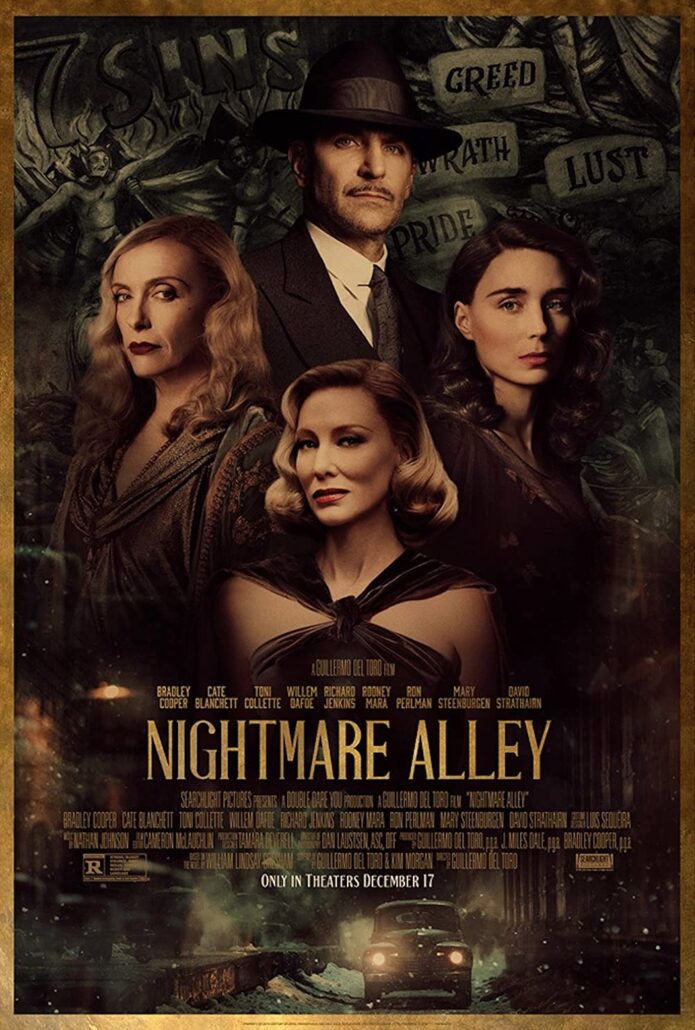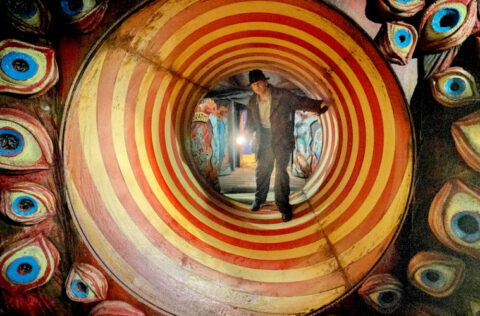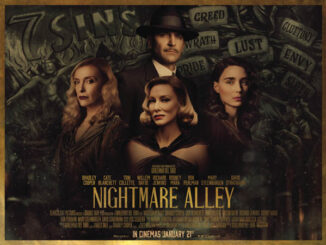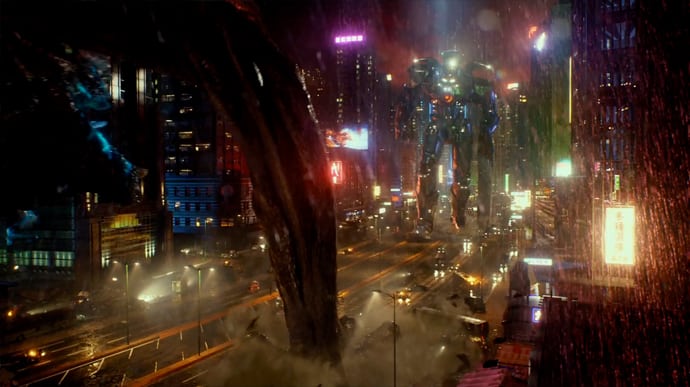Nightmare Alley (2021)
Directed by: Guillermo Del Toro
Written by: Guillermo del Toro, Kim Morgan
Starring: Bradley Cooper, Cate Blanchett, Rooney Mara, Toni Collette
USA
IN CINEMAS NOW
RUNNING TIME: 150 mins
REVIEWED BY: Dr Lenera

In 1939, Stanton “Stan” Carlisle burns down his home after putting a body in a hole in the floor, and takes a job at a traveling carnival. Despite being disturbed by the resident geek [geek shows involved men chasing and eating chicken], and in particular the owner Clem’s method of creating and controlling geeks, Stan begins to enjoy his time with the other carnies. He works with the clairvoyant act Madame Zeena with whom he has a fling, and her alcoholic husband, Pete, as well as falling for Molly, whose act involved being electrocuted. When Stan, possibly accidentally, gives Pete wood alcohol which kills him, he and Molly run away to become a psychic act for the wealthy urban elite of New York. But then he meets psychologist Dr. Lilith Ritter who thinks he’s a con artist….

Based on a 1946 novel by William Lindsey Gresham, Nightmare Alley isn’t really the horror-tinged circus-set thriller that the trailer may have led us to believe. Yes. towards the end there’s some bloody violence, but the circus only features in the first half and Guillermo Del Toro’s first non-fantastical feature is basically an old-fashioned morality tale about the rise and fall of a con-man. Yes, he’s a total conman – unusually for a film these days, there’s not one suggestion that any magic shown could be real, even though the crowds to which some of the characters perform are successfully tricked into believing that it is. There was an earlier version of the book in 1947, which I haven’t seen, but a cursory look at its plot revealed that some details, at least a couple of which are quite important, were altered to satisfy the strict censors of the time, while the ending was changed just a bit to seem more hopeful. Del Toro has said that the screenplay written by him and Kim Morgan was based on the novel which he read way before seeing the first film adaptation, and that he really liked the idea of being able to reverse the alterations made to the latter. So you could say that, while we’ve been awash with remakes for some time and there are more of the things to come, a new version of Nightmare Alley could be more justified than some. I can’t say at all which version is better, but it does seem that the changes may have weakened the 1946 one, and I doubt very much, despite it being filmed in black and white and therefore probably having that classic film noir look which I personally adore, that version is as stylish-looking as this new incarnation, though the very methodical pacing may put some viewers off. One thing’s for sure though; there are certainly monsters in it like every other Del Toro film.
The film really makes an impact immediately with us seeing a man put a body in a hole in the upstairs floor of an empty house, then burn the place down before setting out to find a job. Of course we almost immediately realise that this is our main character, but who was this other person? Did he kill him? Why did he do this? Stan doesn’t even speak for the first 15 minutes or so which adds to his mystery. He comes across the carnival and his first experience is of watching the geek do his chicken chasing and biting act. Said geek is bestial and a few scenes later escapes from his cage and injures Stan, though Stan gets up and knocks him out before he can kill Clem aka Clement Hoakley the boss. Stan only needed to hit him once, but he hits him several times, which is something to think about, though he seems friendly and appears to mean well. When the geek becomes ill, Clem enlists Stan to help him dispose of him, which they do by leaving him in a street in the nearest town just outside a hospital in the pouring rain, even though the trailer for this film fraudulently more than suggested that the geek would play a major part. Oh well. Stan wonders at how any person could sink to the level of performing as a freak, living in a cage in squalor and biting off the heads of chickens to appease the crowd. Clem explains that he seeks out alcoholics or drug addicts who are often men with troubled pasts, lures them in with promises of a temporary job, then gives them opium-laced alcohol. They become dependent on this, and Clem uses this dependence to physically and mentally abuse them until they sink into madness and depravity, thus creating a geeks for his carnival. Stan is uncomfortable with this as we would be, not to mention the medical specimens Clem keeps in jars, but really needs to work so holds back.
Strongman Bruno [the one and only Ron Perlman] doesn’t seem to like him, but Clem, who seemed to hire him because of rather than in spite of Stan not being happy about getting less money for his first job, takes a liking to him, as indeed as does Madame Zeena aka Zeena Crumbian who jumps on him when he’s taking a bath in her makeshift house. However, It’s Molly, whose act with electrocution he thinks he can improve with a chair and an executioner, who he really pines over though – well, we think he does. A small part of this wonders if this is part of an act. Indeed it’s all about being an act. The most interesting early scenes have Zeena and Pete show Stan how they fool patrons into thinking that she has extraordinary mental powers, using an ingenious code system and cold reading which is about very quickly learning about someone by spotting things about them i.e. clothes, hair, mannerisms. Stan was good about picking up stuff before, so when some police come by with the intention of shutting the carnival down, he’s easily able to reduce the aggressive Sheriff to a much weaker person by telling him truths about himself in the manner of Sherlock Holmes., and thus increase his popularity with the carnies. When Pete dies from the alcohol Clem keeps his medical specimens in, the screenplay tries to have it three ways; was this act by Stan, who keeps on refusing drinks himself, an act of mercy, cruel murder or a mistake? In any case, Stan and Molly take the opportunity to flee and we rejoin them two years later when they’re performing for the rich in lush venues. During their latest performance, Dr. Lilith Ritter tries to expose their code system but Stan’s cold reading allows him to best her, keeping their act safe while publicly humiliating Lilith. However, she still realises that Stan is a conman, but is intrigued by his manipulative skill. And her job has allowed her to accumulate sensitive information about various members of New York’s social elite. Maybe they could team up?

There’s a lot of obvious foreshadowing, such as when Pete and Zeena tell Stan that they don’t like to hurt people and always inform customers afterward that the show is a deception. They also warn Stan not to use these skills to continue leading patrons on when it comes to the dead, in what they call a “spook show“. You just know that later on Pete will go against all this. We don’t really get much of a sense of the rich environment of a carnival which other films have managed to achieve, which is a surprise; you’d think that Del Toro, with his sensibility, would dive headfirst into this. Nonetheless I tend to really enjoy films set in the fascinating environment of a circus or carnival, so was most disappointed when this one switched to New York around half way through, though at least it’s a visually stunning New York, the interiors being often quite astonishing in their Art Deco wonder. Green and gold are the dominant hues of this new world that Stan and Molly now find themselves in. They seem dominated by all these huge offices and spacious corridors, while when we go outside, streets are narrow and claustrophobic. Maybe it’s not that period specific, but it suits what we’re watching even we get the feeling that Del Toro is more interested in the psychological aspects of the design of his movie than the psychological aspects of the plot. Detail rather than depth. Even the hotels rooms look amazing thanks to production designer Tamara Deverell’s work, and Del Toro’s recent cinematographer of choice Dan Laustsen also gives us some beautiful snowscapes. Throughout he seems to be lighting from a single source.
Time away from the carnival and the story he’s telling gives Del Toro a chance to put together his tribute to noir cinema, something he’s mentioned that he’s a fan of for some time. So, while we don’t get much of the playing with shadows and pools of black, we still get lighting that’s very moody, characters who are continually enigmatic, cigarettes being continually chain-smoked, an obvious femme fatale, and a hero who could have been played by Robert Mitchum or Alan Ladd [Tyrone Power did the honours in the original]. Unfortunately, the result comes across as pastiche at times, and this means that there’s little emotional investment except for the bits where Stan gets elderly people to apologise for big mistakes in the past. In the most important of these scenes, we’re not sure how we should feel because we don’t like the way that these folk are being exploited, yet here the person did bad things. This is fine, but for the most part the film is rather cold, and, while you could say that this is because the main character is a con artist, the bigger problem is the script which doesn’t seem to nail him. An event or two seem like they happen in the wrong order, and when things eventually turn a bit grand guignol with galloons of blood, it almost feels like we’re watching something different. Unless I was having an unusually observant evening, the finale is sadly telegraphed rather too obviously about half an hour before the end when one character begins to do something, which somewhat lessens its effect, especially when it would have had more power if it had given us one particular scene after the final one. Yes, and I know that probably sounds confusing, but you’ll understand what I mean if you see the film.
Cooper is fine for the most part, though his performance perhaps reveals more than it should at times, so that you wonder why so many people are taken in by him. Leonardo DiCaprio was originally going to play the part, and he would have probably been incredible. Cate Blanchett seems to be virtually going for parody with her femme fatale character Lilith, just as she did with her not dissimilar role in Indiana Jones And The Kingdom Of The Crystal Skull. Nonetheless, her scenes with Cooper do cackle with an energy, even a life, that’s curiously muted most elsewhere. The always excellent Rooney Mara does her very best with a character, Molly, who we don’t really get to know at all and can’t even understand on a couple of occasions, but Willem Dafoe as usual is totally spot on, playing the archetypal sleazy, cruel carnival boss with intelligence. As for Del Toro, he doesn’t seem to struggle himself with telling a story that, for example, even has its only ghost as fake, but despite giving himself a lengthy running time he can’t seem to bring any weight to the story he’s telling despite Pete saying at one point, “People are desperate to be seen, people are desperate to tell you who they are” , settling mostly for aesthetics. Which is still fairly good as far as it goes, and, as one of the few who wasn’t besotted with his last films The Shape Of Water which I found to be hugely flawed [despite it winning Best Picture at the Academy Awards], I was relieved to see that moments of immense idiocy and sledgehammer messaging are not becoming a Del Toro trademark. And, as I said near the beginning of this voice, monsters are still present, only they’re human monsters except for one of Del Toro’s signature creatures, a pickled being named Enoch with a third eye.
Rating: 














Be the first to comment